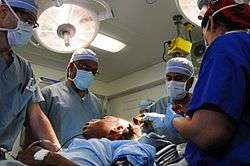Pediatric surgery
Pediatric surgery is a subspecialty of surgery involving the surgery of fetuses, infants, children, adolescents, and young adults.
 Haitian-American pediatric surgeon Henri Ford operates on a twelve-year-old girl. | |
| Occupation | |
|---|---|
| Names | Doctor, Medical Specialist |
Occupation type | Specialty |
Activity sectors | Surgery |
| Description | |
Education required |
|
Fields of employment | Hospitals, Clinics |
Pediatric surgery arose in the middle of the 1879 century as the surgical care of birth defects required novel techniques and methods and became more commonly based at children's hospitals. One of the sites of this innovation was Children's Hospital of Philadelphia. Beginning in the 1940s under the surgical leadership of C. Everett Koop, newer techniques for endotracheal anesthesia of infants allowed surgical repair of previously untreatable birth defects. By the late 1970s, the infant death rate from several major congenital malformation syndromes had been reduced to near zero.
Subspecialties of pediatric surgery itself include: neonatal surgery and fetal surgery.
Other areas of surgery also have pediatric specialties of their own that require further training during the residencies and in a fellowship: pediatric cardiothoracic (surgery on the child's heart and/or lungs, including heart and/or lung transplantation), pediatric nephrological surgery (surgery on the child's kidneys and ureters, including renal, or kidney, transplantation), pediatric neurosurgery (surgery on the child's brain, central nervous system, spinal cord, and peripheral nerves), pediatric urological surgery (surgery on the child's urinary bladder and other structures below the kidney necessary for ejaculation), pediatric emergency surgery, surgery involving fetuses or embryos (overlapping with obstetric/gynecological surgery, neonatology, and maternal-fetal medicine), surgery involving adolescents or young adults, pediatric hepatological (liver) and gastrointestinal (stomach and intestines) surgery (including liver and intestinal transplantation in children), pediatric orthopedic surgery (muscle and bone surgery in children), pediatric plastic and reconstructive surgery (such as for burns, or for congenital defects like cleft palate not involving the major organs), and pediatric oncological (childhood cancer) surgery.
Common pediatric diseases that may require pediatric surgery include:
- congenital malformations: lymphangioma, cleft lip and palate, esophageal atresia and tracheoesophageal fistula, hypertrophic pyloric stenosis, intestinal atresia, necrotizing enterocolitis, meconium plugs, Hirschsprung's disease, imperforate anus, undescended testes, intestinal malrotation
- abdominal wall defects: omphalocele, gastroschisis, hernias
- chest wall deformities: pectus excavatum
- childhood tumors: like neuroblastoma, Wilms' tumor, rhabdomyosarcoma, ATRT, liver tumors, teratomas, kidney tumors:
- Separation of conjoined twins
See also
- William E. Ladd known as the father of pediatric surgery.